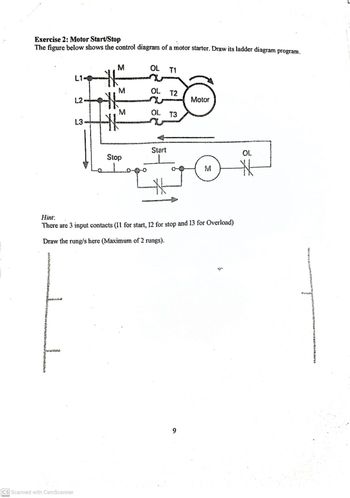
Introductory Circuit Analysis (13th Edition)
13th Edition
ISBN: 9780133923605
Author: Robert L. Boylestad
Publisher: PEARSON
expand_more
expand_more
format_list_bulleted
Question

Transcribed Image Text:Exercise 2: Motor Start/Stop
The figure below shows the control diagram of a motor starter. Draw its ladder diagram program.
JL
L1
CS Scanned with CamScanner
L2.
L3
M
M
M
w
Stop
OL
T1
OL. T2
OL T3
Start
Motor
Hint:
There are 3 input contacts (I1 for start, 12 for stop and 13 for Overload)
Draw the rung/s here (Maximum of 2 rungs).
M
OL
*
Expert Solution
This question has been solved!
Explore an expertly crafted, step-by-step solution for a thorough understanding of key concepts.
This is a popular solution
Trending nowThis is a popular solution!
Step by stepSolved in 2 steps with 1 images

Knowledge Booster
Learn more about
Need a deep-dive on the concept behind this application? Look no further. Learn more about this topic, electrical-engineering and related others by exploring similar questions and additional content below.Similar questions
- Kindly please solve what is ask. I want a complete and handwritten solution so that I can understand. Thank you!!'"arrow_forwardAn automatic starter circuit is to be designed for a shunt motor rated at 20 hp, 240 V, and 75 A. The armature resistance of the motor is 0.12 Ω, and the shunt field resistance is 40 Ω. The motor is to start with no more than 250 percent of its rated armature current, and as soon as the current falls to rated value, a starting resistor stage is to be cut out. How many stages of starting resistance are needed, and how big should each one be? Can you explain the answer with explanatory sketches or steps? Thanks in advance.arrow_forwardComplete the wiring diagrams as per Worksheets 7-A and 7-B then solve for "A" through "K" for the DC motor on Worksheets 7-A and 7-B when it is running at capacity and its specifications are as follows:Rated input = 125 volts, 16 ampsArmature Resistance = 0.3 ohms(Ω)Shunt Field Resistance = 50 ohms (Ω)Series Field Resistance 0.6 ohms (Ω)Rheostat Resistance = 12.5 ohms (Ω)A)power consumed by series field(P-series)a)56.58W b)153.6W c)265.42W d)1523.WB)power consumed by shunt field(P-shunt)a)56.58W b)153.6W c)265.42W d)1523.56WC)power consumed by armature resistance(P-arm)a)56.58W b)153.6W c)265.42W d)1523.56WD)percent efficiency of the machine( % eff) if rotational loses are 850 Wa)30% b)64% c)86% d)99%arrow_forward
- 14.a. Jogging a motor is accomplished byA. manually turning its shaft.B. reducing its armature current.C. momentarily energizing the starter.D. blocking the motor from rotating.14.b. How does change in resistance affect the speed of a DC motor?A. Increasing the armature resistance decreases the motor's speed.B. Reducing the field resistance increases the motor's speed.C. Increasing the field resistance decreases the motor's speed.D. Reducing the armature resistance decreases the motor's speed.arrow_forwardAssume all of the timers are set for a 3 second delay. When the start button is pressed, nothing happens. None of the motors start. Which of the following could NOT cause this problem. a Overload contact OL1 is open b 1CR relay coil is open c 2CR relay coil is open d The stop button is openarrow_forwardComplete the wiring diagrams as per Worksheets 5-A and 5-B then solve for "A" through "G" for the DC motor on Worksheets 5-A and 5-B when it is running at capacity and its specifications are as follows:Rated input = 125 volts, 16 ampsArmature Resistance = 0.3 ohms(Ω)Shunt Field Resistance = 50 ohms (Ω)Series Field Resistance = 0.6 ohm (Ω)Rheostat Resistance = 12.5 ohm (Ω)A) Voltage drop of armature (IR-arm)a) 4.05 V b) 120.95 V c) 125 V d) 129.5 VB) Voltage generated by motor (E-cemf)a) 4.05 V b) 120.95 V c) 125 V d) 129.5 VC) power consumed by shynt field(p-shunt)a) 54.68 W, b) 312.5 W, c) 1632.83 W, d) 2000 WD) power consumend by armature resistance( P-arm)a) 54.68 W , b) 312.5 W, c) 1632.83 W , d) 3000 Warrow_forward
- At its normal operating speed, an electric fan motor draws only 10.8% of the current it draws when it just begins to turn the fan blade. The fan is plugged into a 120.0-V socket. What back emf does the motor generate at its normal operating speed? iarrow_forwardin figure 43-11 when the start button is pushed and the motorstarts in the forward direction, the plugging switch closes. What prevents the reversing contactor from energizing when the plugging switch closesarrow_forwardPlease help with answering this question, please write clearly, thanks. If the motor is operating at full load and if its variable resistance Radj is adjusted to 250 ohms, what is the new speed of the motor?(assume no armature reaction).arrow_forward
arrow_back_ios
arrow_forward_ios
Recommended textbooks for you
 Introductory Circuit Analysis (13th Edition)Electrical EngineeringISBN:9780133923605Author:Robert L. BoylestadPublisher:PEARSON
Introductory Circuit Analysis (13th Edition)Electrical EngineeringISBN:9780133923605Author:Robert L. BoylestadPublisher:PEARSON Delmar's Standard Textbook Of ElectricityElectrical EngineeringISBN:9781337900348Author:Stephen L. HermanPublisher:Cengage Learning
Delmar's Standard Textbook Of ElectricityElectrical EngineeringISBN:9781337900348Author:Stephen L. HermanPublisher:Cengage Learning Programmable Logic ControllersElectrical EngineeringISBN:9780073373843Author:Frank D. PetruzellaPublisher:McGraw-Hill Education
Programmable Logic ControllersElectrical EngineeringISBN:9780073373843Author:Frank D. PetruzellaPublisher:McGraw-Hill Education Fundamentals of Electric CircuitsElectrical EngineeringISBN:9780078028229Author:Charles K Alexander, Matthew SadikuPublisher:McGraw-Hill Education
Fundamentals of Electric CircuitsElectrical EngineeringISBN:9780078028229Author:Charles K Alexander, Matthew SadikuPublisher:McGraw-Hill Education Electric Circuits. (11th Edition)Electrical EngineeringISBN:9780134746968Author:James W. Nilsson, Susan RiedelPublisher:PEARSON
Electric Circuits. (11th Edition)Electrical EngineeringISBN:9780134746968Author:James W. Nilsson, Susan RiedelPublisher:PEARSON Engineering ElectromagneticsElectrical EngineeringISBN:9780078028151Author:Hayt, William H. (william Hart), Jr, BUCK, John A.Publisher:Mcgraw-hill Education,
Engineering ElectromagneticsElectrical EngineeringISBN:9780078028151Author:Hayt, William H. (william Hart), Jr, BUCK, John A.Publisher:Mcgraw-hill Education,

Introductory Circuit Analysis (13th Edition)
Electrical Engineering
ISBN:9780133923605
Author:Robert L. Boylestad
Publisher:PEARSON

Delmar's Standard Textbook Of Electricity
Electrical Engineering
ISBN:9781337900348
Author:Stephen L. Herman
Publisher:Cengage Learning

Programmable Logic Controllers
Electrical Engineering
ISBN:9780073373843
Author:Frank D. Petruzella
Publisher:McGraw-Hill Education

Fundamentals of Electric Circuits
Electrical Engineering
ISBN:9780078028229
Author:Charles K Alexander, Matthew Sadiku
Publisher:McGraw-Hill Education

Electric Circuits. (11th Edition)
Electrical Engineering
ISBN:9780134746968
Author:James W. Nilsson, Susan Riedel
Publisher:PEARSON

Engineering Electromagnetics
Electrical Engineering
ISBN:9780078028151
Author:Hayt, William H. (william Hart), Jr, BUCK, John A.
Publisher:Mcgraw-hill Education,